by Courtney Grimes
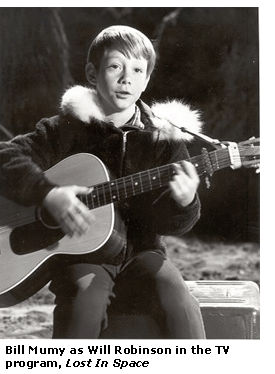 Avid Gibson man Bill Mumy (pronounced Moo-me), best known for his role as Will Robinson in the hit TV series Lost in Space, is celebrating the 46th Anniversary of his career this year. Since 1959, Bill has conquered every facet of the entertainment industry, from television to films, producing to writing, voice-overs and even album recording.
Avid Gibson man Bill Mumy (pronounced Moo-me), best known for his role as Will Robinson in the hit TV series Lost in Space, is celebrating the 46th Anniversary of his career this year. Since 1959, Bill has conquered every facet of the entertainment industry, from television to films, producing to writing, voice-overs and even album recording.
Along with his extremely successful run with Lost in Space, Bill also appeared on numerous television shows including Bewitched, The Munsters, I Dream of Jeannie, Deep Space Nine, The Twilight Zone and starred as Lennier on the popular series Babylon 5 throughout the ’90s.
Bill has starred in 18 feature films including Dear Bridgette, Rascal, Bless the Beasts and Children, Papillion, and It’s a Good Life, and has also established himself as a successful voice-over artist. He has narrated over 50 episodes of A&E’s Biography, as well as documentary specials on A&E, Animal Planet, and E! Entertainment Television. Bill’s voice can also be heard on cartoons such as Ren and Stimpy, Scooby Doo, Batman: the Animated Series, Steven Spielberg’s Animaniacs, and countless others.
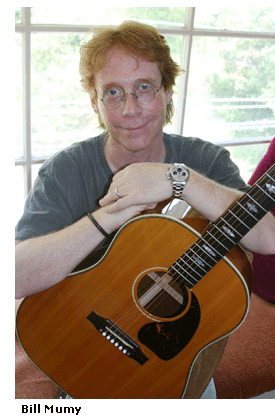
Bill began his venture into the musical world as half of the rock and film duo Barnes and Barnes, who are best known for their song and film Fish Heads.
Barnes and Barnes have recently re-released three CDs, as well as their entire catalog on Oglio, and are currently discussing the recording of their next album.
Bill has also released five solo albums, and nine albums with his band, The Jenerators.
Already having conquered the bulk of the entertainment industry, Bill explored another facet – the world of comic books – one of his true passions. He has written stories for mega comic book distributors Marvel and DC, including Spiderman, The Hulk, Wonderman, and She Hulk (Marvel), and Aquaman, The Spectre, and Star Trek (DC).
Bill has developed his writing in other areas as well, including several short stories which have been published all around the world, and a fantasy novel with co-writer Angela Cartwright.
Between his numerous and ongoing projects, Bill took some time out to chat about his love for making music, his passion for Gibsons, and what he’s dying to do next.
Courtney Grimes: When did you become interested in guitar?
Bill Mumy: I started playing when I was ten. Acoustic. It was folk music that hooked me. I was really into the Kingston Trio, although at that time they were nearing the end of their run. I got into their catalogue as a kid. I took lessons for three or four years, it came naturally and I worked hard at it. I loved it. I had good teachers and I learned a lot of different finger picking styles way back then. I started writing songs when I was 11, and I started playing in bands when I was 14 and learned the rest from jamming with other players. My very first steel string acoustic was a ’65 Gibson B-25. I ended up selling that to Dan Peek of America back in 1972. Wish I’d kept it. I played and sang “Sloop John B” on that guitar on Lost in Space in 1967! In fact, I asked Dan to sell it back to me awhile ago. But he loves it and is keeping it!
CG: Tell me about your Gibsons and Epiphones.
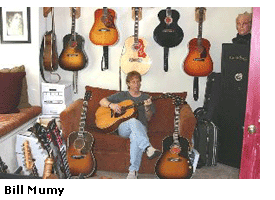
BM: I have a wonderful dark sunburst 1946 Epiphone Triumph Archtop and it’s a great guitar. As nice as any L-5 that I’ve played from the same period. It’s not as fancy, but the tone is in it. Although it’s an acoustic jazz guitar, I’ve used it for some folky stuff and I like the way it sounds when it’s strummed in that style. I also have a ’67 Epiphone Casino – sunburst, 2 pickups, trapeze tailpiece; Lennon – that I’ve recorded a lot with and I used to gig with it with The Jenerators, but I haven’t taken it out for awhile. I have flat wounds on it. Sounds so punchy and it’s got a great jangle in it too.
I also have a couple of newer Epiphone acoustics, one I use as a high strung, that I’ve recorded with a lot. Another I just bought for my son, Seth. He’s 15 and starting to play. He’s loving it. It really sounds great. Nice and bright and even. It’s very easy to play. Amazing value. I just ordered a blonde Emperor Regent and a Jack Cassidy bass. I played one of those basses recently at Truetone Music in Santa Monica and was blown away at how punchy and versatile it is. It sounds similar to my vintage Hofner “Beatle” bass, but it’s got more sounds than that. A few years ago I traded my Gibson L-5, which I regret, and I wanted a true jazz guitar in the house, the Emperor Regent will hopefully fill that slot well. I’m looking forward to getting my hands on it. I don’t play a lot of jazz, but I do get in that mood once in awhile. Nothing I have at home right now really pulls it off.
CG: When you play, do you use any special effects or tunings?
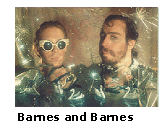
BM: Well, it depends on the situation. I’ve made nine albums of quirky, novelty rock music with my partner, Roberth Haimer, as Barnes and Barnes. When Barnes and Barnes records, I use a decent amount of effects. When I perform live or record with the Jenerators (www.jenerators.com), which is an original Mumy music rock band featuring Miguel Ferrer, I like to keep it really simple. I usually play one of my Les Pauls, the Goldtop mostly.
The only effect I’ve been using with the band, live or on our new CD, Pony Up, is a Red Snapper distortion box or the Seymour Duncan Pickup Booster. With that band it’s almost always a Les Paul. Though last Saturday at our gig I played my Gibson TV Jr. I got it from Gibson back in ’91. It’s got a P-100 in it. I like the jangle in that pickup opposed to the P-90. I love the P-90s in the hollow Epiphone Casino, but on the solid body it’s a bit woofy for me. I like jangle and that P-100 has it.
I use drop-D tunings often and I also always keep a guitar around the house in C tuning and one in open E. Right now, the C tuned guitar is a ’95 Rosewood Gibson J-45 Deluxe. Very pretty guitar that I’ve toured and recorded a lot with. Although I have a lot of different sized acoustics, the Gibson slope shoulder model is by far my all time favorite size guitar. I have three J-45s, from ’95 and 2001, a ’48 Southern Jumbo, a 2002 Advanced Jumbo and a brand new Historic J 160E. I use all of those a lot. I wrote a bunch of new songs on the J 160E and performed with Barnes and Barnes with it last month.
CG: What do you enjoy most, doing television, films, singing, writing or voice-overs?
BM: I’m very lucky to work in so many different arenas of the entertainment industry and I do enjoy them all, but making music – original music – in the studio or live onstage is definitely my favorite thing to do.
CG: How did you get into writing and producing?
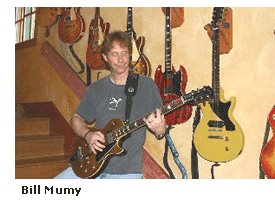
BM: I started writing songs when I was 11, and trust me, I got better! I started writing television shows back in the mid ’70s when I was on a series called Sunshine, that also involved music. It was an NBC series basically about an acoustic trio of musicians that were draft-dodging hippies, raising a little girl in Vancouver. Can you imagine that pitch?! It only lasted one season and two movies of the week.
But we did put out a soundtrack album on MCA and a single that charted. I played guitar, banjo, piano and harmonica on that show. Anyway, I started writing scripts then. In the mid-80s I started writing comic books, a medium I’ve always loved. I have a 360-page sci-fi graphic novel, Lost in Space: Voyage to the Bottom of the Soul coming out in September from Bubblehead Publishing. I’ve produced six CDs of my solo music and four CDs of my band’s, as well as producing other people.
I’ve co-produced my pals Gerry Beckley and Dewey Bunnell (America), who I’ve collaborated with as a songwriter and musician since the ’70s. I’ve performed with them off and on over the years and produced and played on tracks for their CDs. In fact, Gerry and I are just now finishing up a hand full of new songs we’ve written together. Good stuff. And Barnes and Barnes produced two albums for the legendary Wild Man Fisher as well as for Crispin Glover.
CG: Out of all the artists you’ve worked with and collaborated with, do you have a favorite?
BM: That’s almost impossible for me to answer, because it’s such an eclectic palette. I mean, how do I compare playing guitar in Shaun Cassidy’s band on a huge national arena tour in ’78 where it was really like being in A Hard Days Night, to writing songs for the late, great Rosemary Clooney, which was wonderful because she had a voice like heaven and the three songs I wrote that Rosemary recorded were all custom made just for her. How do I compare that to writing and recording with America or Devo or Weird Al Yankovic or even Yogi Bear?! (Barnes and Barnes wrote and produced a Hanna Barbara kids album, This Land is Our Land, with the voices of all their classic cartoon characters.) And I’ve been so lucky to have played with so many great musicians in my life like Jeff Porcarro, Carlos Vega, Steve Lukather, John Stewart, James Taylor, Russ Kunkel… the list goes on and on. I loved every one of those experiences at the time.
CG: You have accomplished more than most people ever think of! Is there anything left that you are dying to do?
BM: Yes! Finish the new solo album I’m recording right now. Russ Kunkel is co-producing it with me and we cut the basic tracks at his studio with Russell on drums and percussion, a really solid bass player – Carlos Cordova, and myself on guitars. All the acoustics are Gibsons.
CG: Which guitars did you use?
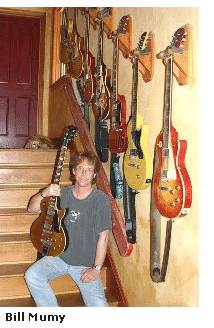
BM: I’ve got a lot of vintage guitars, but I used newer Gibsons for this. I really think the acoustics that Gibson’s been making for the last ten years or so are as good as any the company has ever produced and that’s saying a lot.
I used my custom shop 2001 Blonde J-45 with herringbone inlay on the top and back and Nick Lucas fingerboard inlay for the majority of the tracks. It sounds amazing and plays like butter. I also used my 2002 Gibson Advanced Jumbo. Indian Rosewood not Brazilian.
It’s possibly the best acoustic I own. I like the mahogany on the J-45 for strumming, but for finger picking, the rosewood is a better choice and this guitar is amazing. I also layered some bits with a new Historic Everly Bros. J-180, all maple body, and that guitar sounds and looks really good! I always wanted an Everly guitar. They look so great. I’m really happy I got this one, it’s becoming a favorite.
I also used my 1948 Southern Jumbo on a couple of tracks. That guitar is on almost every song from my last album, After Dreams Come True. And, as a “secret weapon,” I added Russell’s high strung on several songs. It was Nicolette Larson’s and it’s a 3/4 sized, thin hollow body, non- cutaway Gibson from the ’50s with one P-90. I don’t know the exact number of it, but we didn’t plug it in, we just miked it. It’s such a cool sound. It’s almost like a steel string ukulele. Sits in the tracks like jewelry!
I just had Steve Bishop in Nashville add some pedal steel on six tracks and Gerry Beckley and Jeff Foskett are coming in to add some vocals and Gerry’s gonna help with keyboards. So, that’s something I’m really looking forward to, completing this album and getting it out there. I have worked a long time, but it’s mostly been work that I’ve loved. I know how lucky I’ve been and I appreciate the blessings I’ve received. The best way I know to show that appreciation is by giving performances and making music that people can enjoy. And Gibson has always been my number one favorite.
___
[The above article appears courtesy of Gibson.com and is reprinted on Guitar International Magazine with permission. Copyright 2005, Courtney Grimes and Gibson Internet Group. All rights reserved.]
___
Related links
Bill Mumy
Gibson Guitar